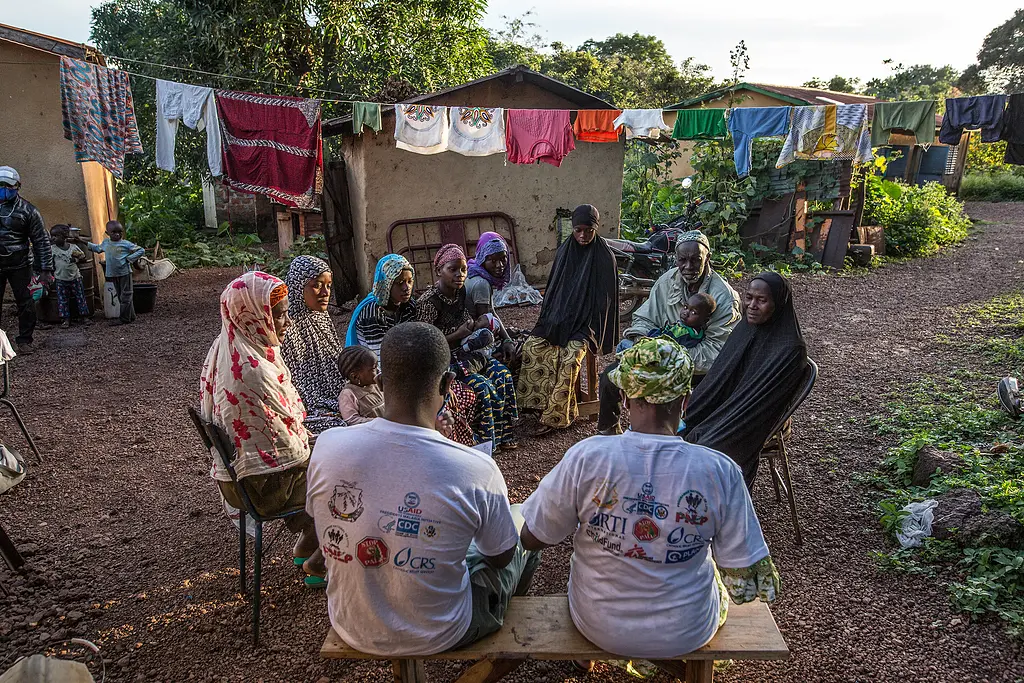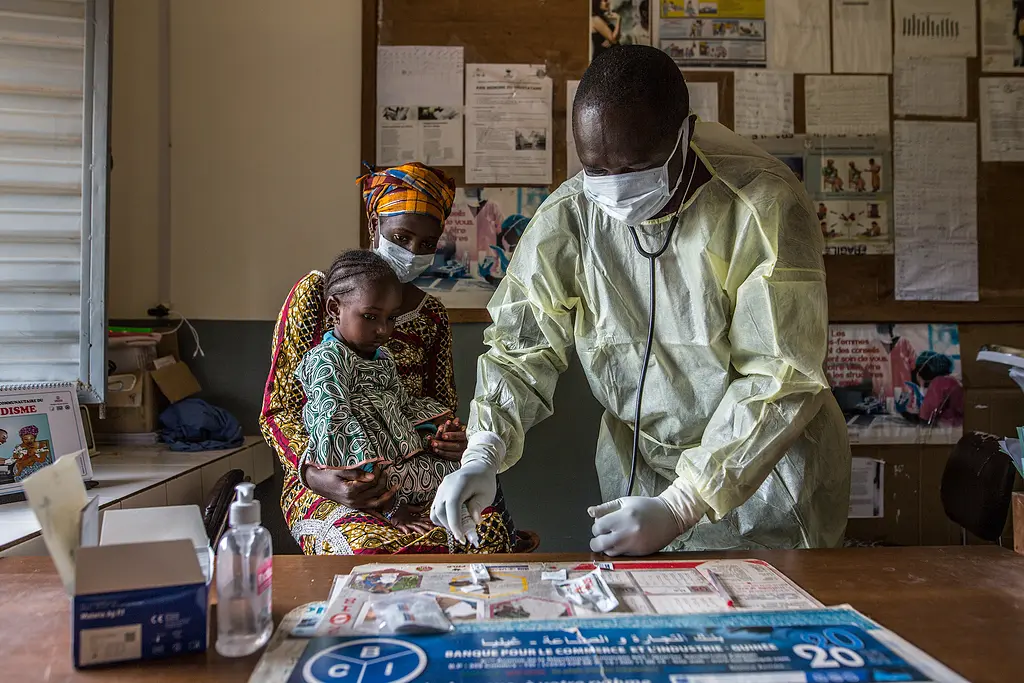USAID's StopPalu+ project protects children in Guinea by integrating health services
Recommended by the World Health Organization since 2012, seasonal malaria chemoprevention (SMC) campaigns are a critically important tool in protecting young children from malaria. These campaigns typically involve giving long-acting anti-malarial medicine to all children under five years of age once per month over four to five months during the rainy season when mosquitoes are most active. If effectively deployed, it is estimated that SMC reduces malaria burden by up to 70%.
Seasonal Malaria Chemoprevention in Guinea
Like many other countries in West Africa, Guinea has been implementing SMC for several years in up to 17 districts, which—with other interventions such as malaria case management, intermittent preventive therapy for pregnant women, and insecticide-treated bed nets—has resulted in a major impact on malaria trends. Since 2012, the prevalence of malaria in children under five years of age has decreased from 44% to less than 17%.
RTI & USAID Partner to Implement Seasonal Malaria Chemoprevention
Through the USAID | Guinea StopPalu and StopPalu+ programs, RTI has been supporting the Ministry of Health to control malaria in the country for the past 10 years. When planning and implementing SMC campaigns, the National Malaria Control Program and StopPalu+ would often collaborate with staff from the Ministry of Health childhood immunization program, coordinating planning, training, and campaign schedules, ensuring that schedules would not overlap and resources would not clash to ensure the successful implementation of each campaign.
We were sharing our experiences, and then just wondered out loud, why we could not integrate both campaigns. No one could come up with a reason why it was not possible, and in fact the World Health Organization was advocating for countries to consider such integration. So, as a first step, to assess how feasible such integration would be, our SMC teams in five districts in Labé region were complemented by one person from the ministry’s childhood immunization program to vaccinate any child, pregnant woman and mother that were deficient in their immunizations. – Dr. Keita Sitan, StopPalu+ Senior Technical Manager
The Labé region was chosen since it has one of the lowest rates of childhood immunization, with 38% of children under the age of two years not having had one vaccine administered.

StopPalu+ staff explaining to the community in Labé the SMC and immunization campaigns, as well as answering any questions that the community may have. Photo credit: Sadak Souici | RTI International
Adding Immunization Activities to the Seasonal Malaria Chemoprevention Campaign
Prior to the final round of the last SMC campaign, StopPalu+ coordinated SMC and immunization activities with the Ministry of Health, as well as other partners such as the World Health Organization, the United Nations Children's Fund and the Global Alliance for Vaccines and Immunization. Health personnel identified at health facilities which children, pregnant women, and recent mothers still needed their full immunizations, campaign staff were trained in both campaigns’ activities and data collection forms, and health facility infrastructure such as refrigerators and freezers were assessed for their functionality to store vaccines. Joint teams of three SMC campaign personnel and three immunization campaign personnel visited all households in the five districts.
Over the one-week period of the campaign, the integrated teams were able to administer 10,013 vaccine dosages to children for polio, diptheria, tetanus, whooping cough, measles, yellow fever, and meningitis, and to pregnant women and recent mothers for tetanus. Of the 4,823 children that had been identified as having an incomplete vaccination package, 91% were brought up to schedule; of the 2,641 women that had been identified as being deficient in their tetanus vaccination schedule, 84% were brought up to schedule. Additionally, the integrated team tested 15,046 people with fevers for malaria, of whom 32% tested positive and all of whom were treated.

“Almost there.” Preparations underway to administer SMC and immunizations for a mother and child in Labé district. Photo credit: Sadak Souici | RTI International
Importantly, adding immunization activities to the SMC campaign did not negatively impact SMC coverage, with the fourth round of the SMC campaign still reaching more than 95% of eligible children under five years of age. The feedback from communities and health personnel on the integration of both campaigns was also overwhelmingly positive.
I appreciated not having to incur the inconvenience, time, and cost to go to the health facilities to get immunizations for myself and my two youngest children. I am glad that my children now have taken the pills that will protect them from malaria and the vaccines to protect them from things like measles. – Aisha Camara, a mother in Labé district.
Similarly, health personnel appreciated the ability to meet their programmatic immunization coverage targets, proactively diagnose and treat malaria cases, and learn from each other’s programs.

Rainy season is malaria season. Testing a child with fever for malaria in Labé health center. Photo credit: Sadak Souici | RTI International
Expanding Integrated Efforts for the Future
Based on this successful pilot of integrating both SMC and immunization campaigns, the Ministry of Health and various stakeholders, including StopPalu+, are discussing how to build on this experience and expand integration of these two programmatic activities, including addressing the challenges observed and incorporating the lessons learned. For example, one challenge was the multitude of registers for both campaigns, some of which collected the same information and some of which did not request the right information. This presents an opportunity to revise and streamline the registers to ensure all necessary data is collected and gain efficiencies in the time campaign teams must spend at each household.
Guinea has limited resources at its disposal to improve the health of our population. Only by maximizing the resources we do have—infrastructure, human and financial—are we able to meet programmatic goals and targets, and help the country develop socio-economically. Integrating malaria intervention campaigns like SMC with immunization campaigns is one example of how we kill two birds with one stone and maximize the resources available. – Dr. Sitan
….
Funded by USAID | Guinea under the U.S. President’s Malaria Initiative, StopPalu+ is implemented by RTI International, in collaboration with Medical Care Development, Jhpiego, Project C.U.R.E., Centre Africain de Formation pour le Développement, Club des Amis du Monde, Comité des Jeunes Mon Avenir D’abord, Initiatives et Actions pour l’Amélioration de la Santé des Populations, and Solidarité Guinéenne pour le Dévelopement.
Learn more about the program here.
- U.S. President's Malaria Initiative
- U.S. Agency for International Development (USAID)
- Jhpiego
- Centre Africain de Formation pour le Développement (CENAFOD)
- Medical Care Development International
- National Malaria Control Program
- Association pour la Promotion des Initiatives Communautaires (APIC)
- Club des Amis du Monde (CAM)
- Comité des Jeunes Mon Avenir D’abord (CJMAD)
- Initiatives et Actions pour l’Amélioration de la Santé des Populations (INAASPO)
- Solidarité Guinéenne pour le Dévelopement (SGPD)
- Project C.U.R.E.

